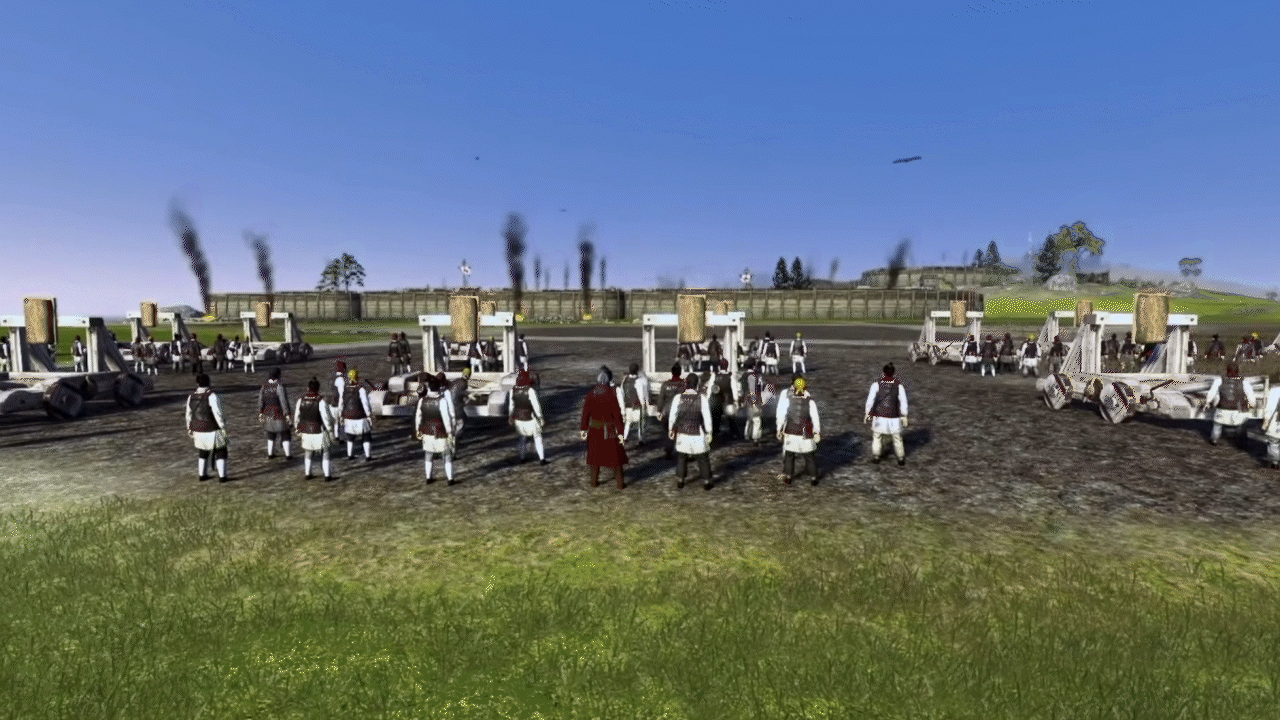Catapulting corpses?
A famous case of medieval biological warfare probably never happened
Catapulting corpses?
Anibal / Adobe
A famous case of medieval biological warfare probably never happened
By Matt Field
August 10, 2023
Poke through the history of biological weapons long enough and you will likely come across a particularly macabre claim. In 1346, the story goes, an army of the Golden Horde—an offshoot of Genghis Khan’s Mongol empire—was laying siege to Caffa, a Genoese trading center on the Crimean Peninsula. But as Janibeg, the ruler of the Golden Horde, waited for Caffa to surrender, his fighters began to succumb to a mysterious ailment. “It was as though arrows were raining down from heaven to strike and crush” the Mongols, a notary from the city of Piacenza in present-day Italy wrote. According to the 14th century account, the beleaguered Mongol commanders had one final move: to hurl their plague dead over the fortress walls.
In Gabriele de Mussi’s narrative, the Genoese inside the fort soon fell ill. They clambered aboard their ships and fled toward Italy—to Genoa, Venice, and other ports, carrying with them the very plague they sought to escape. “It was as if they had brought evil spirits with them: every city, every settlement, every place was poisoned by the contagious pestilence,” the notary wrote. Known as the Black Death, the bubonic plague crippled Europe when it arrived in 1347, killing perhaps 50 million people. If de Mussi’s tale were true, the Mongol siege had been a devastating biological attack.
The story has certainly stuck.
Since de Mussi’s work was re-discovered in a university library in Poland in 1842, researchers of weaponry, the plague, and biological warfare have picked up parts of its narrative. Look up “The Black Death” in the Encyclopedia Britannica and it’s right there: “With his forces disintegrating, Janibeg used trebuchets to catapult plague-infested corpses into the town in an effort to infect his enemies. From [Caffa], Genoese ships carried the epidemic westward…” The medieval allegations are in YouTube and TikTok videos by the History Channel and others, some with millions of views. In the academic literature the anecdote can be found in reputable publications ranging from the Journal of the American Medical Association to the CDC’s Emerging Infectious Diseases.
The problem is, there’s strong reason to doubt de Mussi.
Jean Pascal Zanders, a veteran scholar of weapons of mass destruction, has been looking into de Mussi’s Caffa claims as part of a project on the history of biological and chemical warfare. He argues that the story doesn’t comport with how medieval artillery worked, the geography of Caffa, or medieval warfare practices. “A picture that seems to be plausible on a very basic level actually doesn’t stand up to scrutiny,” Zanders said.

Interpreting de Mussi. By the mid-1800s, Zanders said, scholars had converged on the idea that the plague had originated in the East, somewhere in Asia, and travelled westward toward Europe. The re-discovery of de Mussi’s tale provided them with a back-dated confirmation of the by-then popular theory. The corpse-flinging part was an afterthought.
For decades, some scholars who referenced de Mussi even seemed to miss a critical fact: The notary wasn’t in Caffa during the siege. That didn’t matter much if the point was to cite evidence that the plague originated in Asia, but if the Mongols really catapulted plague-dead into Caffa, de Mussi didn’t see it. Records from his home in Piacenza attest to him being there the whole time, Zanders said.
It wasn’t until the 20th century that scholars started giving the catapulting claim more serious consideration. This, Zanders said, grew out of an interest in military history. One turning point occurred after a British sports and weapons enthusiast, Ralph Payne-Gallwey, wrote about ancient and medieval artillery and devoted a chapter of his 1907 The Projectile Throwing Engines of the Ancients to the trebuchet, a catapult-like siege engine used to launch heavy stones at fortresses. In his book, Payne-Gallwey cited numerous medieval references “to the practice of throwing dead horses into a besieged town with a view to causing a pestilence therein.” The work helped establish the idea of trebuchets as powerful weapons commonly used by medieval armies to spread disease.
Subsequently, de Mussi’s assertions about the corpses were included in prestigious publications. Writing in 1966 in the Journal of the American Medical Association, Vincent J. Derbes, a medical doctor, noted Payne-Gallwey’s assessments of trebuchets as well as another anecdote of body launching to conclude that “there is every reason to accept the feasibility of hurling plague-ridden cadavers over the city walls.” In 2002, University of California, Davis professor Mark Wheelis likewise wrote in Emerging Infectious Diseases that the Mongols would have camped one kilometer from Caffa’s walls in order to be safe from the city’s defenders and that the front lines would have been 250 to 300 meters from the walls. He argued that trebuchets could have launched diseased cadavers across that distance and thereby spread the plague. Rats harboring fleas carrying the plague bacterium, Yersinia Pestis, conversely, according to Wheelis, could not have travelled that far. The evidence, Wheelis wrote, suggested that “the hurling of plague cadavers might well have occurred as [de Mussi] claimed, and if so, that this biological attack was probably responsible for the transmission of the disease from the besiegers to the besieged.”
The Stockholm International Peace Research Institute (SIPRI) amplified both scholars, first in 1971 and then in 1999, when Wheelis wrote a chapter on early biological warfare, which covered, in part, the Caffa siege. “And SIPRI books are like the Bible,” Zanders said, noting their credibility in the field. As the leader of SIPRI's chemical and biological weapons program at the time, Zanders had a hand in reviewing Wheelis’s chapter, but because of limited data available to him, he said he wasn’t able to challenge the narrative.
A handful of publications helped de Mussi’s story become “historical fact,” Zanders said.
RELATED POSTS
A landscape from the 1790s depicting Caffa, now called Feodosia. The old Genoese city and its walls are visible in the distance. Gottfried Heinrich Geißler via Wikimedia Commons.
Trebuchets and the geography of Caffa. Trebuchets were the culmination of medieval siege engine design, reigning as the most powerful artillery for centuries until cannons began to replace them in the late Middle Ages. Derbes wrote that from experiments and other sources, Payne-Gallwey had determined the largest trebuchets could throw an object weighing 300 pounds a distance of 300 yards. According to de Mussi’s account, catapults were used to fling bodies over the walls at Caffa, but both Derbes and Wheelis implied that these would have been trebuchets, the best of which could theoretically launch a human payload.
But there are several problems with accepting that the Mongols launched cadavers with trebuchets.
For one, no trebuchet has ever been found, Zanders said. What’s left to history are historical references or drawings that lack perspective. Following in the footsteps of Payne-Gallwey and his experiments, researchers and trebuchet fans on YouTube have re-imagined what the weapons must have looked like, constructing their own. But these are modern re-creations that may not accurately reflect medieval capabilities.
Even if trebuchets had a range of 300 yards, as Payne-Gallwey concluded, Caffa would have been suboptimal terrain for them, Zanders argues. The hilly topography would have made it challenging to launch non-aerodynamic bodies up hills and over walls. The Mongols would have had to place their trebuchets close to the fortress, where they would have been vulnerable to defensive fire. And Zanders said people were living outside of the city walls, meaning there would have been opportunities for the plague to spread between the besiegers and the besieged.
The most powerful trebuchets weighed tens of tons. Dismantling and moving them would have been a massive logistical operation. Across most terrains, Zanders said, the weapons were “too huge to transport” and would have been built on site using local wood. Zanders couldn’t find reference in his research to there being suitable trees around Caffa with which to build trebuchets. “One thing that stood out was the absence of trees in descriptions,” he said. “Many shrubs and other things and low trees, but definitely nothing like oak trees—solid wood to build these types of machines.”
A video with 2.3 million views on the Smithsonian Institution's YouTube channel shows a reconstructed trebuchet in action. Smithsonian Channel/YouTube.
Medieval warfare. The Middle Ages have a gruesome and violent reputation; think Vlad the Impaler, Ivan the Terrible, or William the Conqueror. And Zanders believes part of what makes de Mussi’s tale of the Siege of Caffa believable are arguments about how common it was to catapult dead bodies or large animals. Indeed, the historical record includes several instances of this sort of attack. But through analyzing a variety of sources, Zanders undercuts many of the claims.
“We see that the chronicler was never a contemporary of the described events,” Zanders said during one recent presentation on his research. “The narrative emerged decades, if not longer, after the reported incidents. Different narratives can exist of the same event. However, the most intriguing aspect is that in all of those narratives, we only will see or read about a single incident of catapulting cadavers during a war or a whole campaign. There is never a suggestion of a wider practice.”
For example, according to one history of the Hundred Years’ War—a multi-generational conflict between England and France between 1337 to 1453—as French forces laid siege to a castle in Thun l’Eveque, France, they launched horses at their enemies, causing a stench that allegedly drove the castle’s defenders to consider surrender. Jean Froissart, a medieval writer, recounted the story in his book Les Chroniques, lending credibility to the idea that trebuchets could launch dead animals (or even humans) at a besieged fortress. But Zanders looked into the claim and found several reasons to doubt its veracity. Froissart, born in the 1330s, would have been a young child at the time of the siege in 1340. Parts of his narrative appear to be copied from another chronicler, Jean le Bel, who witnessed the conflagration but didn't mention siege engines or animal projectiles. Also, one version of Froissart’s tale that Zanders analyzed doesn't contain a description of launching horses.
Likewise, Zanders was not able to corroborate the tale of a 1422 siege at Karlštejn Castle in the present-day Czech Republic. Again, the chronicler, Antoine de Varillas, seemed to be the only person to describe the hurling of war dead.
Screengrabs from TikTok videos relaying aspects of Gabriele de Mussi's tale of the Siege of Caffa.
How de Mussi’s claim took hold. The plague is believed to have originated in Central Asia and trade in Crimea may have played a role in spreading it to Europe. But that doesn’t mean that the Mongol siege of Caffa, whether it involved cadaver launching or not, was responsible. Wheelis, who found de Mussi’s story to be plausible, nevertheless wrote that the “[p]lague appears to have been spread in a stepwise fashion, on many ships rather than on a few.”
The way de Mussi crafted his tale may have been akin to a game of medieval telephone. The notary wasn’t in Caffa, but Piacenza, near Genoa, where he likely would have come in contact with returning traders. He might then have worked the details he heard from them into a second-hand narrative comporting with his religious convictions about righteous Christians and the contemporary theory of disease transmission, namely that foul air or miasma caused sickness. Zanders theorizes that de Mussi at that point may have settled on a reasonable synthesis: God struck down the Mongols and miasma, brought on by the catapulted bodies, spread the plague among the Genoese. “He is a firsthand chronicler of what other people were telling him, but the construction had to fit with his conception of the world. And he got confused,” Zanders said. “And that's probably what has happened.”
And the game of telephone appears to be going on still, with one researcher or writer citing a previous one, without first figuring out if de Mussi's claim is true. “Anybody writing something on biological weapons,” Zanders said, “particularly people starting out in the field or writing an essay for school or university, they will always mention it. And it's always like one or two sentences they're going to use; nobody develops the issue further.”
Seth Carus, a scholar of biological and chemical warfare who was a professor at the National Defense University, supports Zanders’s analysis. “As Zanders has illustrated, there is reason to doubt the claim that biological warfare was waged at Caffa, yet the story is repeated as though it has been proven beyond a shadow of a doubt,” he told the Bulletin. Many biosecurity experts, he said, probably believe the oft-told tale, despite a lack of evidence. That can have an impact beyond the community of plague or military history buffs.
“My fear,” Carus said, “is that repeating false claims of past biological warfare normalizes the idea of intentional use of disease, making the actual use of biological weapons more likely.”
Together, we make the world safer.
The Bulletin elevates expert voices above the noise. But as an independent, nonprofit media organization, our operations depend on the support of readers like you. Help us continue to deliver quality journalism that holds leaders accountable. Your support of our work at any level is important. In return, we promise our coverage will be understandable, influential, vigilant, solution-oriented, and fair-minded. Together we can make a difference.
Keywords: bioweapons, black death, catapult, plague, siege of caffa, trebuchet
Topics: Biosecurity
















